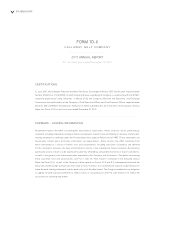Callaway 2011 Annual Report Download - page 17
Download and view the complete annual report
Please find page 17 of the 2011 Callaway annual report below. You can navigate through the pages in the report by either clicking on the pages listed below, or by using the keyword search tool below to find specific information within the annual report.robots, launch monitors, a proprietary virtual test center, a proprietary performance analysis system, an indoor
test range and other methods to develop and test its products. Through the use of these technologies, the
Company has been able to accelerate and make more efficient the design, development and testing of new golf
clubs and golf balls.
For certain risks associated with product design and development, see below, “Certain Factors Affecting
Callaway Golf Company” contained in Item 1A.
Manufacturing
The Company’s golf clubs are assembled using components obtained from suppliers both internationally
and within the United States. Significant progress has been made in automating certain facets of the
manufacturing process during the last few years and continued emphasis will be placed on automated
manufacturing by the Company. However, the overall golf club assembly process remains fairly labor intensive,
and requires extensive global supply chain coordination. With respect to golf balls, although a significant amount
of labor is still used, the overall manufacturing process is much more automated than the golf club assembly
process.
As of December 31, 2011, the Company substantially completed the final phase of its planned Global
Operations Strategy Initiatives (see Note 3 “Restructuring Initiatives” to the Notes to Consolidated Financial
Statements). These initiatives were designed to add speed and flexibility to meet customer service demands,
optimize efficiencies, and facilitate long-term gross margin improvements. During 2011, the Company
(i) completed the reorganization of its manufacturing and distribution centers located in Carlsbad, California,
Toronto, Canada, and Chicopee, Massachusetts, (ii) transitioned to the use of third-party logistics in Dallas,
Texas and Toronto, Canada, and (iii) completed the establishment of a new production facility in Monterrey,
Mexico. As a result of these changes, during 2011, approximately 79% and 67% of the Company’s golf club and
golf ball production volume, respectively, was generated in regions outside the U.S. compared to 60% during
2010 for both golf clubs and golf balls. At the conclusion of 2011, almost all of the Company’s golf club
production volume and 75% of golf ball production volume was generated in regions outside of the United
States. The Company maintains limited golf club assembly in its facilities in Carlsbad, California and
manufactures the balance of golf ball production volume at its facility in Chicopee, Massachusetts.
Raw Materials
The Company purchases raw materials from numerous domestic and international suppliers in order to meet
scheduled production needs. Raw materials include steel, titanium alloys and carbon fiber for the manufacturing
of golf clubs, and rubber, plastic ionomers, zinc sterate, zinc oxide and lime stone for the manufacturing of golf
balls. For certain risks associated with golf club and golf ball manufacturing, see below, “Certain Factors
Affecting Callaway Golf Company” contained in Item 1A.
Sales and Marketing
Sales in the United States
Of the Company’s total net sales, approximately 47%, 48% and 50% were derived from customers within
the United States in 2011, 2010 and 2009, respectively. The Company primarily sells to both on- and off-course
golf retailers and sporting goods retailers who sell quality golf products and provide a level of customer service
appropriate for the sale of such products. The Company also sells certain products to mass merchants. On a
consolidated basis, no one customer that distributes golf clubs or golf balls in the United States accounted for
more than 6% of the Company’s consolidated revenues in 2011, 2010 and 2009. On a segment basis, the golf ball
customer base is more concentrated than the golf club customer base. In 2011, the top five golf ball customers
accounted for approximately 22% of the Company’s total consolidated golf ball sales. A loss of one or more of
these customers could have a significant adverse effect upon the Company’s golf ball sales.
3
























